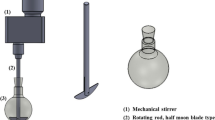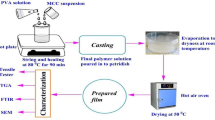Abstract
A sustainable hydrogel fabricated from carboxymethylated modified cellulose crosslinked by epichlorohydrin was applied successfully for dewatering of orange juice. The obtained equilibrium water retention values of this hydrogel were 911, 143 and 82 g water/g hydrogel in distilled water, 0.9% NaCl solution and raw orange juice, respectively. The amount of water absorbed by the hydrogel dipped in orange juice depended on the juice/hydrogel weight ratio. With the use of a juice/hydrogel weight ratio of 200, the concentration of each nutrient increased by ~ 69%, which could be increased more with the use of lower weight ratio. The hydrogel showed good reswelling behavior, losing only ~ 5% of its capability to reabsorb water in orange juice when reused in three consecutive cycles. The reswelling property revealed the reusability of the hydrogel for dewatering of orange juices. This innovative process—dewatering of fruit juice by cellulose-based hydrogel—could also be applied for dewatering of apple juice, grape juice, pineapple juice, tomato juice, and coal fines and activated sludges.
Graphic abstract








Similar content being viewed by others
References
Alam MN, Christopher LP (2017) A novel, cost-effective and eco-friendly method for preparation of textile fibers from cellulosic pulps. Carbohydr Polym 173:253–258
Alam MN, Christopher LP (2018) Natural cellulose-chitosan cross-linked superabsorbent hydrogels with superior swelling properties. ACS Sustain Chem Eng 6:8736–8742
Alam MN, Islam MS, Christopher LP (2019) Sustainable production of cellulose-based hydrogels with superb absorbing potential in physiological saline. ACS Omega 4(5):9419–9426
Buchholz FL, Graham AT (1997) Modern superabsorbent polymer technology, 1st edn. Wiley, New York
Buchholz FL, Graham AT (1998) Modern superabsorbent polymer technology. Wiley- VCH, New York
Casaburi A, Rojo UM, Cerrutti P, Vazquez A, Foresti ML (2018) Carboxymethyl cellulose with tailored degree of substitution obtained from bacterial cellulose. Food Hydrocolloids 75:147–156
Chaiyasat A, Jearanai S, Christopher LP, Alam MN (2019) Novel superabsorbent materials from bacterial cellulose. Polym Int 68:102–109
Chen W, Bu Y, Li D, Liu C, Chen G, Wan X, Li N (2020) High-strength, tough, and self-healing hydrogel based on carboxymethyl cellulose. Cellulose 27:853–865
Cipriano BH, Banik SJ, Sharma R, Rumore D, Hwang W, Briber RM, Raghavan SR (2014) Superabsorbent hydrogels that are robust and highly stretchable. Macromolecules 47:4445–4452
Dang HT, Narbaitz RM, Matsuura T, Khulbe KC (2006) A comparison of commercial and experimental ultrafiltration membranes via surface property analysis and fouling Tests. Water Qual Res J Canada 41:84–93
Flory PJ (1953) Principles of polymer chemistry. Cornell University Press, New York
Jiao B, Cassano A, Drioli E (2004) Recent advances on membrane processes for the concentration of fruit juices: a review. J Food Eng 63:303–324
Kim DI, Gwak G, Zhan M, Hong S (2019) Sustainable dewatering of grapefruit juice through forward osmosis: improving membrane performance, fouling control, and product quality. J Membr Sci 578:53–60
Lee WF, Wu RJ (1996) Superabsorbent polymeric materials. I. Swelling behaviors of crosslinked poly(sodium acrylate-co-hydroxyethyl methacrylate) in aqueous salt solution. J Appl Polym Sci 62:1099–1114
Lee KP, Arnot TC, Mattia D (2011) A review of reverse osmosis membrane materials for desalination—development to date and future potential. J Membr Sci 370:1–22
Lin J, Rouseff RL, Barros S, Naim M (2002) Aroma composition changes in early season grapefruit juice produced from thermal concentration. J Agric Food Chem 50(4):813–819
Lin F, Zheng J, Guo W, Zhu Z, Wang Z, Dong B, Lin C, Huang B, Lu B (2019) Smart cellulose-derived magnetic hydrogel with rapid swelling and deswelling properties for remotely controlled drug release. Cellulose 26:6861–6877
Liu Y, Xie JJ, Zhu MF, Zhang XY (2004) A Study of the synthesis and properties of AM/AMPS copolymer as superabsorbent. Macromol Mater Eng 289:1074–1078
Navarra MA, Bosco CD, Moreno JS, Vitucci FM, Paolone A, Panero S (2015) Synthesis and characterization of cellulose-based hydrogels to be used as gel electrolytes. Membranes 5:810–823
Omidian H, Zohuriaan-Mehr MJ (2002) DSC studies on synthesis of superabsorbent hydrogels. Polymer 43:269–277
Peng X-W, Zhong L-X, Ren J-L, Sun R-C (2012) Highly effective adsorption of heavy metal ions from aqueous solutions by macroporous Xylan-Rich hemicelluloses- based hydrogel. J Agric Food Chem 60(15):3909–3916
Priyadarshini A, Priyadarshini A (2018) Market dimensions of the fruit juice industry. Fruit Juices Chap 2:15–32
Rastogi NK (2016) Opportunities and challenges in application of forward osmosis in food processing. Crit Rev Food Sci Nutr 56:266–291
Rastogi N (2018) Reverse osmosis and forward osmosis for the concentration of fruit juices. Elsevier, Amsterdam
Rosa F, Bordado J, Casquilho M (2004) Dynamic and equilibrium swelling of a sulfonic acid superabsorbent copolymer in salt solutions. J Polym Sci Part B Polym Phys 42:505–514
Sant’Anna V, Marczak LDF, Tessaro IC (2012) Membrane concentration of liquid foods by forward osmosis: process and quality view. J Food Eng 111:483–489
Sherif MA, Keshk S (2008) Homogenous reactions of cellulose from different natural sources. Carbohyd Polym 74:942–945
Sim G, Alam MN, Godbout L, van de Ven TGM (2014) Structure of swollen carboxylated cellulose fibers. Cellulose 2:4595–4606
Sun DW (2014) Emerging technologies for food processing. Elsevier, Amsterdam
Wang WB, Xu JX, Wang AQ (2011) A pH-, salt- and solvent responsive carboxymethylcellulose-g-poly(sodium acrylate)/medical stone superabsorbent composite with enhanced swelling and responsive properties. eXPRESS Polym Lett 5:385–400
Wang Y, Xiao G, Peng Y, Chen L, Fu S (2019) Effects of cellulose nanofibrils on dialdehyde carboxymethyl cellulose based dual responsive self-healing hydrogel. Cellulose 26:8813–8827
Yang H, Tejado A, Alam MN, Antal M, van de Ven TGM (2012) Films prepared from electrosterically stabilized nanocrystalline cellulose. Langmuir 28:7834–7842
Yoshimura T, Matsuo K, Fujioka R (2006) Novel biodegradable superabsorbent hydrogels derived from cotton cellulose and succinic anhydride: synthesis and characterization. J Appl Polym Sci 99:3251–3256
Zhang M, Cheng Z, Zhao T, Liu M, Hu M, Li J (2014) Synthesis, characterization, and swelling behaviors of salt-sensitive maize bran–poly(acrylic acid) superabsorbent hydrogel. J Agric Food Chem 62(35):8867–8874
Zhao Y, Kang J, Tan T (2006) Salt-, pH- and temperature responsive semi-interpenetrating polymer network hydrogel based on poly (aspartic acid) and poly(acrylic acid). Polymer 47:7702–7710
Acknowledgments
The authors want to acknowledge financial support of a NSERC Strategic Project Grant (506303-17) and the industrial partner FPInnovations.
Author information
Authors and Affiliations
Corresponding author
Ethics declarations
Conflict of interest
The authors declare that they have no known competing financial interests or personal relationships that could have appeared to influence the work reported in this paper.
Additional information
Publisher's Note
Springer Nature remains neutral with regard to jurisdictional claims in published maps and institutional affiliations.
Electronic supplementary material
Below is the link to the electronic supplementary material.
Rights and permissions
About this article
Cite this article
Islam, M.S., Alam, M.N. & van de Ven, T.G.M. Sustainable cellulose-based hydrogel for dewatering of orange juice. Cellulose 27, 7637–7648 (2020). https://doi.org/10.1007/s10570-020-03295-3
Received:
Accepted:
Published:
Issue Date:
DOI: https://doi.org/10.1007/s10570-020-03295-3




